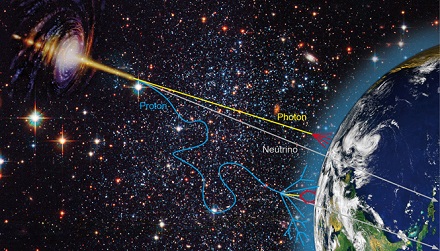
The messengers of interest are:
- Photons in multiple wavelength bands (e.g. radio, infrared, optical, ultraviolet, X-rays, gamma-rays)
- Neutrinos at MeV (solar and supernova neutrinos) and TeV-PeV (presumably of extragalactic origin) energies
- Cosmic rays, observed over 12 orders of magnitude in energy
- Gravitational waves, which are so far observed for two classes of events (black hole-black hole and neutron star-neutron star mergers)
Theoretical models establish connections between the different messengers, which reveal where in a certain object the messengers are produced, how their signals are connected, and, eventually, what can be learned about the source in general. One example is the role of cosmic neutrinos, which are a smoking gun signature for the acceleration of cosmic-ray nuclei - which in turn cannot be traced back directly to the source because they are deflected by magnetic fields. Another example is the timing information between gravitational wave events and photon signals, which can be used to infer information on the production region of the photons and other possible messengers.




